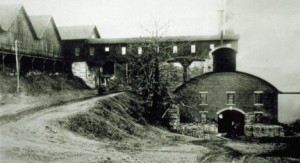How the did the iron ore get into the furnace?
That’s an interesting question!
The simple answer is that iron ore, charcoal, and limestone were dumped into the top of the furnace, but there’s more to it than that.
The way it got to the top of the furnace was via a bridge that ran from the top of the furnace across Lower Road to the top of the “charging wall”
The charging wall the high stone wall you see on the north side of the road, across from the furnace. Workers pushed wheelbarrows of iron ore, of charcoal, and of limestone across that bridge to the furnace.

(Here’s a photo of a charcoal cart — it could hold a lot of charcoal. The carts for limestone and iron ore were smaller because limestone and iron ore are heavier.)

You can see the bridge in this photo — it’s one of the missing links in the reconstructed furnace. It was enclosed (to keep the charcoal, iron ore, and limestone dry, not to mention the walkway where the men wheeled the wheelbarrows) and you can see it running from the charcoal sheds in the upper left to the top of the furnace on the right.
Before they could dump it in, the blast had to be stopped briefly — and when that was done, the workers had to hustle to get the wheelbarrows dumped before the blast restarted. If the blast was stopped for too long, the liquid iron and slag already in the furnace would solidify. If the blast wasn’t stopped long enough, the workers with the wheelbarrows could have been asphyxiated by the carbon monoxide from the furnace forced into the room where they were dumping their wheelbarrows.
Something to think about: Today we have machines that handle feeding blast furnaces, usually operating under computer control. Yet at Beckley Furnace people did that job using wheelbarrows. What might have caused the change in methods over the years? What have been some of the effects of this kind of change?

